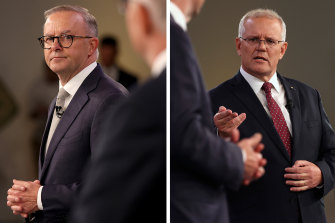Scott Morrison and Anthony Albanese make their pitch to 4.6 million uncommitted voters
Prime Minister Scott Morrison and Opposition Leader Anthony Albanese have both framed the looming election as a referendum on the past three years of Coalition government – rather than a contest of new ideas – in direct pitches to Australia’s 4.6 million uncommitted voters.
In a pair of opinion pieces commissioned by The Sun-Herald and The Sunday Age four weeks out from polling day on May 21, both men have laid out their visions for Australia’s future – while emphasising the risks presented by their opponents.
Opposition Leader Anthony Albanese and Prime Minister Scott Morrison have made their pitches to uncommitted voters.Credit:Jason Edwards
Morrison framed the contest as one between a stronger or weaker economy and a stronger or more uncertain future at a time of global turmoil. Albanese, meanwhile, spelled out Labor’s plans in several key areas before pivoting to perceived government failings.
The most recent Resolve Political Monitor, conducted during week one of the campaign when Albanese made significant gaffes on the unemployment rate and the cash rate and Morrison at one point appeared to walk away from a federal integrity commission, showed the number of uncommitted voters rose sharply from 21 to 27 per cent.
Similarly, while 40 per cent of the 100 undecided voters who attended the first leader’s debate last Wednesday gave the contest to Albanese, and 35 per cent to Morrison, there was another 25 per cent unconvinced by either man.
An uncommitted voter is someone who leans towards a candidate but, as Resolve director Jim Reed said, “[They] haven’t locked their choice in yet.
“[This campaign has been] about convincing voters that the leader can be trusted for the next three years and that the other guy is a risk not worth taking.”
“What I read into that is that people have been looking solely at the government, judging their record, but the start of the campaign has focused people on a choice. Anthony Albanese had his missteps at exactly that time too, which perhaps made people rethink.”
It’s those still-persuadable people – approximately 4.6 million of Australia’s 17.2 million registered voters – that Morrison and Albanese must convince in the next month in a contest that many pundits expect will go right down to the wire, with a hung parliament a distinct possibility.
Senior members of the Coalition and Labor frontbenches, who spoke on condition of anonymity to The Sun-Herald and The Sunday Age so they could frankly assess the campaign to date, said seats including Reid, Gilmore and Parramatta in NSW; Corangamite, McEwen and Chisholm in Victoria; Swan, Pearce and Hasluck in WA; Longman, Leichhardt and Brisbane in Queensland; and the Tasmanian trio of Bass, Braddon and Lyons were all still in play.
“It’s an arm-wrestle and I’d prefer to be us than them at this stage, but we could also lose it,” one member of the shadow cabinet said.
The “teal” independents pushing into formerly safe Liberal-held seats such as North Sydney, Wentworth, Goldstein and Kooyong meant “this time they’re fighting on two fronts, as we have been against the Greens for some time”.
A cabinet minister said the second week had been a draw but, “We’re talking about national security, which is good for us.
“I think we’re in a pretty good spot, Morrison is campaigning well, he’s got the stamina whereas Albanese has lost a bit of confidence,” the minister said.
In his exclusive opinion piece, Morrison writes: “On almost any measure – fatality rates, vaccine rates, economic growth, jobs growth, or debt levels – Australia’s recovery is leading the world.
“Just two years ago, Treasury predicted unemployment could rise to 15 per cent. A generation of young people were at risk of having their opportunity to get ahead in life stolen. Today unemployment is just 4 per cent, the equal lowest level in nearly 50 years.”
However, the prime minister said Australia could not take its strong position for granted, highlighting a recent warning from the International Monetary Fund that risks to the global economy had “worsened significantly” because of the war in Ukraine, with global price rises of 7.4 per cent forecast in 2022.
In contrast, Albanese outlined Labor’s plans for cheaper childcare and electricity, the revival of manufacturing, more skills training and a federal integrity commission – before presenting a shopping list of Morrison government’s failings.
“The government has a record of delivering flat wages, the decline of manufacturing, the scandalous crisis in aged care, the nationwide labour shortage and has failed to assert Australia’s political interests in the Pacific region,” Albanese wrote.
“The government’s response is always too little, too late. We saw this during the black summer fires, the failure to order vaccines and rapid antigen tests and with the recent floods.”
The government was out of touch and out of time, Albanese wrote, before pivoting to the future: Labor had “concrete policies and a team with the experience to deliver a better future for Australians”.
In a campaign with little policy differentiation nor any great vision for reform, Resolve’s Reed said election 2022 was “a highly presidential contest, where the focus is on the leaders, not their respective teams or local candidates”.
“It’s about convincing voters that the leader can be trusted for the next three years and that the other guy is a risk not worth taking.”
Read the full text of Anthony Albanese’s piece here and Scott Morrison’s piece here.
Cut through the noise of the federal election campaign with news, views and expert analysis from Jacqueline Maley. Sign up to our Australia Votes 2022 newsletter here.
Most Viewed in Politics
From our partners
Source: Read Full Article
